Nissan Vehicle Code Fault C1155: Causes and Solutions
The C1155 fault code is a common issue that affects various Nissan vehicle models. This diagnostic trouble code (DTC) is primarily associated with the Anti-lock Braking System (ABS) and can trigger multiple warning lights on the dashboard. This guide will explore the causes, symptoms, and solutions for the C1155 fault code in a Nissan vehicle. […]
The C1155 fault code is a common issue that affects various Nissan vehicle models. This diagnostic trouble code (DTC) is primarily associated with the Anti-lock Braking System (ABS) and can trigger multiple warning lights on the dashboard. This guide will explore the causes, symptoms, and solutions for the C1155 fault code in a Nissan vehicle.

What is the C1155 Fault Code?
The C1155 fault code in a Nissan vehicle is typically related to the brake system, specifically indicating a problem with the brake fluid level or the brake fluid level sensor. This code is part of the vehicle’s On-Board Diagnostics (OBD) system, which monitors various components and systems to ensure optimal performance and safety.
Affected Nissan Vehicle Models
While the C1155 code can appear in various Nissan models, it has been most reported in:
- Nissan Murano
- Nissan Frontier
- Nissan Altima
- Nissan Rogue
- Nissan Sentra
It’s important to note that the exact interpretation and implications of the C1155 code may vary slightly between different Nissan models and model years.
Symptoms Associated with C1155
When a Nissan vehicle experiences the C1155 fault, several symptoms may manifest:
- Dashboard Warning Lights: The most common symptom is the illumination of multiple warning lights on the dashboard. These typically include:
- ABS (Anti-lock Braking System) light
- BRAKE warning light
- VDC (Vehicle Dynamic Control) light
- SLIP indicator light
- Reduced Brake System Functionality: In some cases, the vehicle’s advanced braking features may be temporarily disabled, including:
- ABS (Anti-lock Braking System)
- VDC (Vehicle Dynamic Control)
- TCS (Traction Control System)
- EBD (Electronic Brake force Distribution)
- Spongy Brake Pedal: Some drivers report a soft or spongy brake pedal feel when the C1155 code is present.
- Intermittent Warning Light Activation: The warning lights may come on and off intermittently, especially after hard acceleration or driving on rough terrain.
Primary Causes of the C1155 Fault Code
Several factors can trigger the C1155 fault code in a Nissan vehicle:
- Low Brake Fluid Level: The most common cause of the C1155 code is a low brake fluid level in the master cylinder reservoir, which can be due to normal brake pad wear, a leak in the brake system, or improper fluid levels after a recent brake service.
- Faulty Brake Fluid Level Sensor: The brake fluid level sensor, located in the master cylinder reservoir, may malfunction and incorrectly report a low fluid level even when the fluid is at the proper level.
- Wiring Issues: Damaged or corroded wiring in the brake fluid level sensor circuit can cause false readings and trigger the C1155 code.
- Air in the Brake System: In some cases, air trapped in the brake lines or ABS module can cause erratic brake fluid level readings and trigger the fault code.
- ABS Wheel Speed Sensor Problems: Although less common, issues with the ABS wheel speed sensors, particularly the left front sensor, have been reported to trigger the C1155 code in some Nissan models.
Diagnostic Process for C1155
When addressing the C1155 fault code in a Nissan vehicle, it’s essential to follow a systematic diagnostic process:
- Visual Inspection:
- Check the brake fluid level in the master cylinder reservoir.
- Inspect for any visible brake fluid leaks around the master cylinder, brake lines, calipers, and wheel cylinders.
- Examine the condition of the brake pads and rotors for excessive wear.
- Scan Tool Analysis:
- Use an OBD-II scan tool to retrieve and clear the fault codes.
- Check for any additional codes that may be present alongside C1155.
- Brake Fluid Level Sensor Test:
- Test the brake fluid level sensor using a multimeter to ensure it’s functioning correctly.
- Inspect the wiring and connections to the sensor for any damage or corrosion.
- Brake System Bleeding:
- If air in the system is suspected, perform a thorough brake system bleeding procedure.
- This may require special equipment to bleed the ABS module properly.
- ABS Wheel Speed Sensor Inspection:
- Check the ABS wheel speed sensors, particularly the left front sensor, for proper operation and clean connections.
- Advanced Diagnostics:
- In some cases, advanced diagnostic equipment may be necessary to test the ABS module and other electronic brake control components.
Solutions and Repairs for C1155
Depending on the root cause of the C1155 fault code, several repair options may be necessary:
- Brake Fluid Top-up or Replacement:
- If the brake fluid level is low, top it up to the proper level using the manufacturer-recommended brake fluid.
- A complete brake fluid flush and replacement may be necessary if the fluid is old or contaminated.
- Brake Fluid Level Sensor Replacement:
- If the sensor is faulty, it will need to be replaced. This typically involves removing the sensor from the master cylinder reservoir and installing a new one.
- Proper bleeding of the brake system is crucial after sensor replacement.
- Wiring Repairs:
- Repair or replace any damaged or corroded brake fluid level sensor circuit wiring.
- Ensure all connections are clean and secure.
- Brake System Bleeding:
- Perform a thorough brake system bleeding procedure to remove air from the lines and ABS module.
- This may require specialized equipment for proper ABS module bleeding.
- ABS Wheel Speed Sensor Replacement:
- If you identify a faulty ABS wheel speed sensor, replace it with a new, OEM-quality sensor.
- Clean the sensor mounting area and ensure proper installation.
- ABS Module Service:
- In rare cases, you may need to service or replace the ABS module itself if it’s the source of the problem.
- This is typically a job for a professional mechanic or a dealership.
Preventive Measures
To reduce the likelihood of encountering the C1155 fault code in a Nissan vehicle, consider the following preventive measures:
- Regular Brake Fluid Checks: Routinely inspect the brake fluid level and condition. Replace the fluid according to the manufacturer’s recommended maintenance schedule.
- Timely Brake Pad Replacement: Replace brake pads before they wear excessively, which can lead to low brake fluid levels.
- Address Leaks Promptly: If you notice any brake fluid leaks, have them repaired immediately to prevent low fluid levels and potential air intrusion into the system.
- Use Quality Parts: When replacing brake components, use high-quality, OEM or equivalent parts to ensure proper fit and function.
- Professional Brake Services: Have brake system services performed by qualified technicians familiar with Nissan vehicles and their specific brake system requirements.
Impact on Vehicle Safety and Performance
The C1155 fault code, while primarily related to the brake fluid level sensor, can have significant implications for vehicle safety and performance:
- ABS Functionality: With the ABS potentially disabled, the vehicle may have a reduced ability to maintain steering control during hard braking, especially on slippery surfaces.
- Traction Control: The deactivation of the VDC and TCS systems can lead to reduced stability and traction in challenging driving conditions.
- Brake Performance: If actual low brake fluid levels trigger the code, it could indicate worn brake pads or a leak in the system, both of which can compromise braking effectiveness.
- False Alarms: In cases where the sensor is faulty but the brake system is otherwise normal, drivers may ignore legitimate warning lights in the future, potentially missing critical safety alerts.
Case Studies and Owner Experiences
Several Nissan vehicle owners have shared their experiences with the C1155 fault code:
- 2014 Nissan Murano: An owner reported that the C1155 code appeared along with multiple warning lights. Initially thought to be a wheel speed sensor issue, it was later determined to be a low brake fluid level caused by normal brake pad wear.
- Nissan Altima: A forum member described intermittent activation of warning lights associated with the C1155 code. The issue persisted after replacing rotors and pads and flushing the brake fluid. This suggests that the problem may be more complex in some cases than a simple low fluid level.
- Nissan Frontier: An owner experienced the C1155 code along with a spongy brake pedal. The issue was resolved by bleeding air from the ABS module, highlighting the importance of proper brake system bleeding procedures.
These case studies underscore the variety of potential causes for the C1155 code and the importance of thorough diagnostics.
Address Fault Codes At A Nissan Dealership
The C1155 fault code in Nissan vehicles, while often related to brake fluid levels, can stem from various issues within the brake system. From simple fluid top-ups to more complex sensor or ABS module problems, addressing this code requires a systematic approach to diagnosis and repair.
Vehicle owners experiencing the C1155 code should take it seriously, as it can impact critical safety systems like ABS and stability control. While some causes of the code can be addressed by knowledgeable DIY enthusiasts, complex issues involving the ABS often require professional diagnosis and repair at a Nissan dealership.
Regular maintenance, including brake fluid checks and timely brake pad replacements, can help prevent many issues leading to the C1155 code. By staying proactive with vehicle care and addressing warning lights promptly, Nissan vehicle owners can ensure their vehicles maintain optimal safety and performance on the road.


